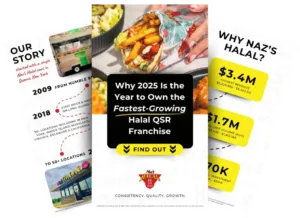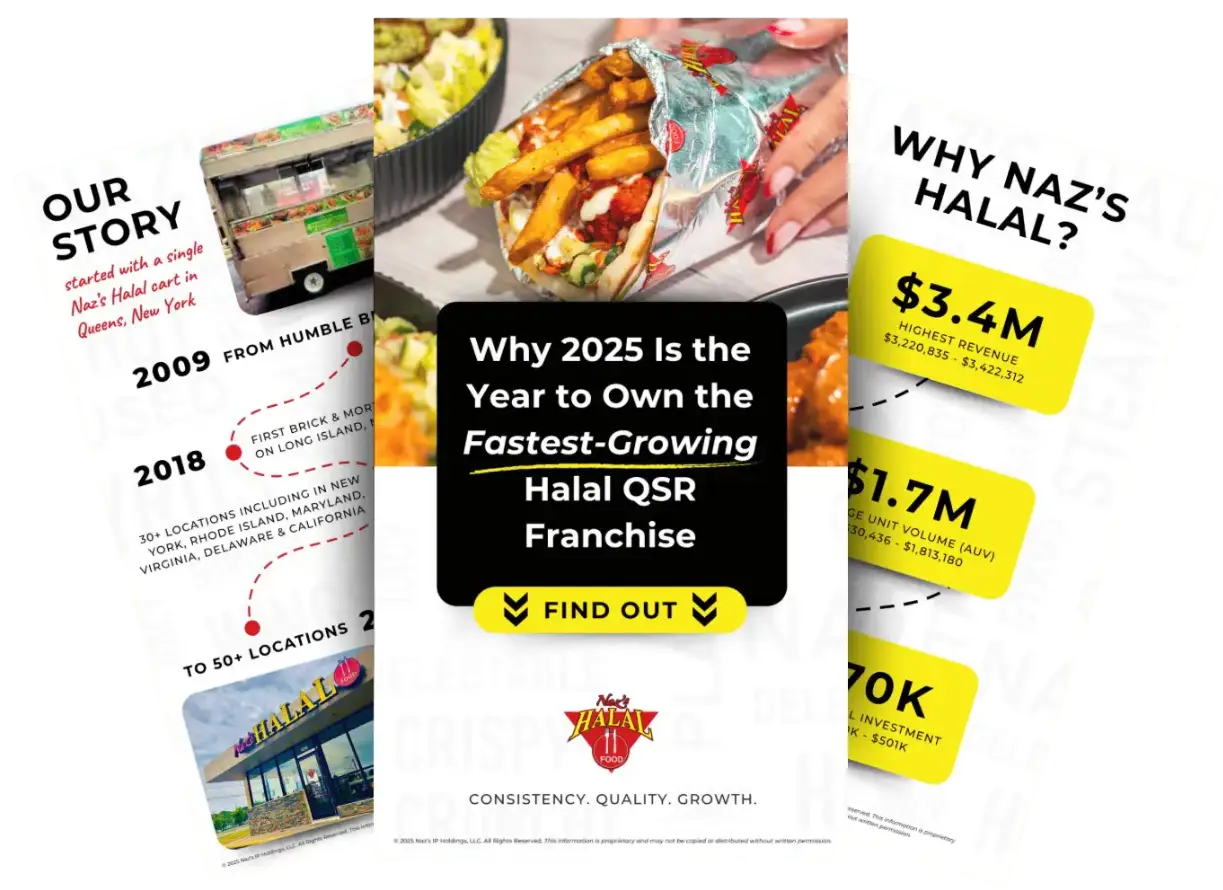
Fast food franchising in 2025 looks very different than it did a decade ago. Rising food costs, tighter margins, labor volatility, and shifting consumer preferences have created a new reality: brand name alone doesn’t cut it anymore.
If you’re evaluating a food franchise this year, you need to think like a portfolio operator, not just a fan of the food. This guide breaks down what top-performing franchisees are actually looking at before they sign—and how to make sure you’re buying into a scalable, sustainable business model, not just a logo.
Download: Why 2025 Is the Year to Own One of the Fastest-Growing Halal QSR Franchises
1. Look at Unit-Level Performance — Not Just System Sales
The first mistake most new buyers make? Focusing on systemwide sales instead of individual unit performance. A franchise brand might post impressive numbers across 500 locations—but if the top 10% of stores are carrying the rest, that’s not sustainable.
What to ask:
- Is Item 19 in the FDD fully filled out with real revenue data?
- Are the top 25% of units significantly outperforming the average (and why)?
- What are new stores doing in Year 1—not just legacy locations?
Example: Naz’s Halal, a fast-casual halal brand, discloses an Average Unit Volume (AUV) exceeding $1.6 million in Item 19. That data point, backed by franchisees already expanding to second and third locations, shows real performance—not just projections.
2. Analyze the Operational Model, Not Just the Menu
A great product doesn’t equal a great business. Many food franchise buyers fall for exciting menus that are operational nightmares. The better question is: How easy is this concept to run profitably with minimal labor, waste, and downtime?
Look for:
- A limited SKU menu that supports high throughput
- Simple, replicable processes that don’t require culinary skill
- Systems to manage food cost, prep time, and peak-hour volume
Avoid concepts that require chef talent, niche equipment, or daily supplier calls to keep the kitchen running.
3. Evaluate the Training and Support Infrastructure
Good franchises don’t just offer training—they build infrastructure around it.
Ask:
- Is training hands-on, structured, and multi-day?
- Are you supported through tech tools (e.g., POS training, real-time dashboards)?
- What happens after opening week—are there dedicated field consultants?
Example: Naz’s Halal includes 100 hours of classroom and kitchen-based training, tech stack onboarding, and ongoing coaching that includes access to tools like Superorder that not only assist with reputation management, but also chargebacks.
 Get Our Kit
Get Our Kit
4. Assess Buildout Timeline and Cost Control
Fast food should mean fast to open—but many franchises tie operators down with expensive, custom layouts and long timelines. In today’s market, a flexible, lower-overhead buildout is often the difference between scaling and stalling.
What to check:
- What support does the franchisor provide for finding the ideal location?
- How long from lease signing to opening?
- Does the franchisor have tools to optimize the build out process?
- How much of the investment is driven by design standards vs. operational needs?
Lean, counter-service buildouts usually offer faster ROI and fewer permitting delays, especially in competitive metros.
5. Pay Attention to Cultural Fit and Market Timing
Some of the best-performing QSR brands in 2025 are those aligned with larger shifts in consumer identity, food values, and community relevance. It’s not just about serving food—it’s about being culturally meaningful and easy to trust.
Look for concepts that:
- Serve growing or underserved demographics – for example, late-night halal QSR
- Offer transparency in sourcing and clear labeling (e.g., halal, plant-based, allergen-friendly)
- Fit in a multi-ethnic, urban, or value-conscious consumer base
Example: Brands like Naz’s Halal are capitalizing on the mainstreaming of halal, offering culturally-rooted food with broad appeal. Their positioning reflects current trends among Gen Z and Millennial diners looking for clean-label, authentic, and affordable options.
Learn More: Why 2025 Is the Year to Own One of the Fastest-Growing Halal QSR Franchises
6. Bonus: Ask What Multi-Unit Operators Are Doing
Franchisees who already own other brands are often the first to spot operational winners. If they’re reinvesting, that’s a strong signal. If they’re pulling back—or worse, selling—you should ask why.
Choose Systems, Not Just Hype
The best fast food franchise in 2025 isn’t the one with the most TikTok views. It’s the one with:
- Proven unit-level performance
- A simplified, scalable operating model
- Clear training and support
- Smart buildout economics
- Demand-driven, culturally relevant positioning

